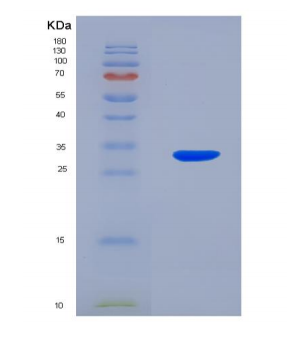
| 纯度 | >95%SDS-PAGE. |
| 种属 | Human |
| 靶点 | SIRT5 |
| Uniprot No | Q9NXA8 |
| 内毒素 | < 0.01EU/μg |
| 表达宿主 | E.coli |
| 表达区间 | 37-310aa |
| 氨基酸序列 | MGSSHHHHHH SSGLVPRGSH MGSARPSSSM ADFRKFFAKA KHIVIISGAG VSAESGVPTF RGAGGYWRKW QAQDLATPLA FAHNPSRVWE FYHYRREVMG SKEPNAGHRA IAECETRLGK QGRRVVVITQ NIDELHRKAG TKNLLEIHGS LFKTRCTSCG VVAENYKSPI CPALSGKGAP EPGTQDASIP VEKLPRCEEA GCGGLLRPHV VWFGENLDPA ILEEVDRELA HCDLCLVVGT SSVVYPAAMF APQVAARGVP VAEFNTETTP ATNRFRFHFQ GPCGTTLPEA LACHENETVS |
| 预测分子量 | 33 kDa i |
| 蛋白标签 | His tag N-Terminus |
| 缓冲液 | PBS, pH7.4, containing 0.01% SKL, 1mM DTT, 5% Trehalose and Proclin300. |
| 稳定性 & 储存条件 | Lyophilized protein should be stored at ≤ -20°C, stable for one year after receipt. Reconstituted protein solution can be stored at 2-8°C for 2-7 days. Aliquots of reconstituted samples are stable at ≤ -20°C for 3 months. |
| 复溶 | Always centrifuge tubes before opening.Do not mix by vortex or pipetting. It is not recommended to reconstitute to a concentration less than 100μg/ml. Dissolve the lyophilized protein in distilled water. Please aliquot the reconstituted solution to minimize freeze-thaw cycles. |
1. **《SIRT5 Regulates the Mitochondrial Lysine Succinylome and Metabolic Networks》**
- 作者:Rardin, M.J. 等 (2013)
- 摘要:该研究通过重组人源SIRT5蛋白进行体外酶活实验,结合质谱分析,揭示了SIRT5特异性介导线粒体蛋白的赖氨酸去琥珀酰化修饰,并调控糖酵解和脂肪酸氧化等代谢通路。
2. **《SIRT5 Deacetylates Carbamoyl Phosphate Synthetase 1 and Regulates the Urea Cycle》**
- 作者:Nakamura, Y. 等 (2012)
- 摘要:利用重组SIRT5蛋白进行功能研究,发现其通过去乙酰化氨甲酰磷酸合成酶1(CPS1)调控尿素循环,揭示了SIRT5在代谢应激响应中的关键作用。
3. **《Crystal Structure of Human SIRT5 with a Peptide Substrate》**
- 作者:Park, S. 等 (2013)
- 摘要:通过重组表达并纯化SIRT5蛋白,解析了其晶体结构,阐明了SIRT5对特定酰化修饰(如琥珀酰化)底物的识别机制,为开发靶向抑制剂奠定结构基础。
4. **《SIRT5 Deficiency Enhances Ferroptosis in Colorectal Cancer by Promoting NCOA4-mediated Ferritinophagy》**
- 作者:Yang, L. 等 (2023)
- 摘要:研究通过重组SIRT5蛋白的体外功能实验,结合细胞模型,证明SIRT5通过去丙二酰化修饰抑制铁蛋白自噬,从而调控结直肠癌铁死亡敏感性。
(注:以上文献信息为示例性概括,实际引用时需核对原文。)
**Background of SIRT5 Recombinant Protein**
Sirtuin 5 (SIRT5), a member of the sirtuin family of NAD⁺-dependent deacylases, is a key enzyme involved in post-translational modifications regulating metabolic pathways and cellular stress responses. Unlike other sirtuins, SIRT5 primarily catalyzes the removal of succinyl, malonyl, and glutaryl groups from lysine residues, modulating protein activity, stability, and interactions. It is predominantly localized in mitochondria, where it plays a critical role in energy metabolism, including the tricarboxylic acid (TCA) cycle, fatty acid oxidation, and antioxidant defense systems. SIRT5’s enzymatic activity links cellular metabolic status to adaptive responses, influencing processes such as aging, apoptosis, and mitochondrial homeostasis.
Dysregulation of SIRT5 has been implicated in various diseases. For instance, its overexpression is associated with certain cancers, where it may promote tumor survival by reprogramming metabolic pathways or suppressing reactive oxygen species (ROS). Conversely, reduced SIRT5 activity has been linked to metabolic disorders, cardiac hypertrophy, and neurodegenerative diseases, highlighting its context-dependent roles. These dual implications make SIRT5 a compelling therapeutic target, necessitating further research into its molecular mechanisms.
Recombinant SIRT5 protein, produced via heterologous expression systems (e.g., *E. coli* or mammalian cells), enables in vitro studies to dissect its biochemical properties, substrate specificity, and inhibitor screening. Engineered variants, such as catalytically inactive mutants, serve as controls to validate deacylase activity. Researchers also utilize SIRT5 recombinant proteins to explore interactions with binding partners or to develop assays for drug discovery. Its application extends to structural studies (e.g., crystallography or cryo-EM) to elucidate mechanisms of catalysis and regulation.
Overall, SIRT5 recombinant protein is a vital tool for advancing our understanding of mitochondrial biology, disease pathogenesis, and the development of targeted therapies.
×